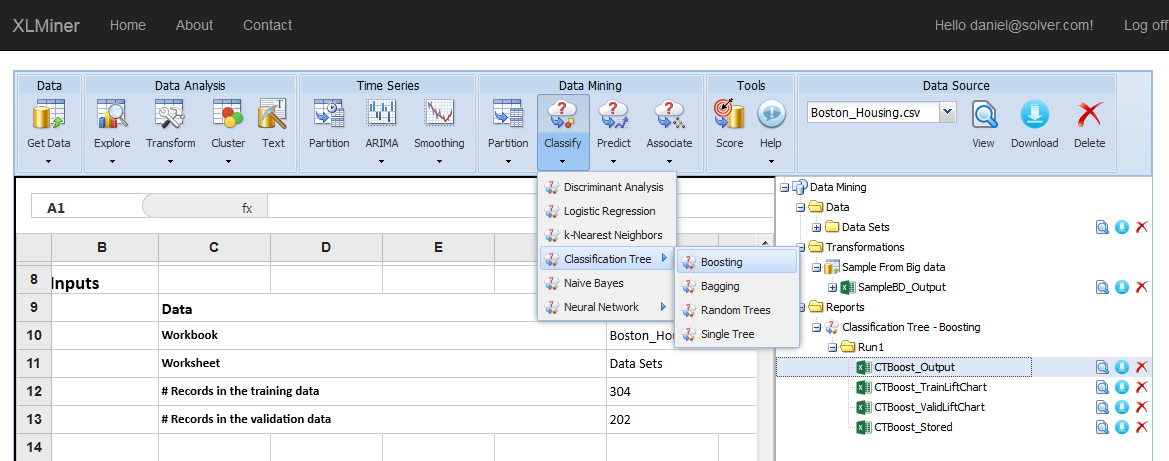Frontline's predictive analytics tools just took two "quantum leaps": We've introduced XLMiner SDK, a new, powerful toolkit for software developers who want to use data mining and text mining in their own applications, and we've introduced XLMiner.com, "predictive analytics software as a service" with point-and-click ease. The XLMiner® brand now covers predictive analytics in desktop Excel with XLMiner Pro and Platform, in Excel Online and Google Sheets with XLMiner Analysis ToolPak, on the Web for everyone with XLMiner.com, and embedded in applications with XLMiner SDK.
XLMiner for the Web
Developers working in C++, C#, Java, Python or R can jump down to our discussion of XLMiner SDK, but let's start with a tool that anyone can use: XLMiner.com is a new SaaS (software as a service) platform for data mining, text mining, forecasting, and predictive analytics using only a browser. It offers business analysts point-and-click tools to create predictive analytics models themselves, without being expert data scientists or programmers.
To use XLMiner.com, you simply visit the site and register to create an account. Then you can bring in data from Excel workbooks, CSV files, SQL databases, or our Apache Spark Big Data cluster, explore and transform your data, use a wide range of machine learning methods to build a model with predictive power for your data, and evaluate and compare different models. It's all point-and-click, and if you've used XLMiner in Excel, you already know how to use XLMiner.com.

Our airline case study, originally done in Excel, shows how XLMiner users can build predictive models from Big Data that match the accuracy of a similar HortonWorks case study using a public FAA airline dataset, but without any of the complexity of Hadoop, Pig, Python and other developer tools. The same point-and-click operations can be used in XLMiner.com, with only your web browser.
XLMiner SDK
If you're an application developer working in C++, C#, Java, Python or R, XLMiner SDK gives you a powerful, high-level API for quickly embedding predictive analytics in your own application. You can get results with just a few high-level lines of code, and you have full control to create a workflow where you specify all aspects of data analysis, machine learning, and scoring.
XLMiner SDK provides full API support for five popular programming languages: C++ 11 or later, C# 4.0 or later, Java 8, Python 2.7 or 3.4 (both are supported), and R 3.2 with R6 classes. In most interactive development environments such as Microsoft Visual Studio and R Studio, you'll benefit from automatic recognition and “command completion” for XLMiner’s objects, properties and methods. For C++, C# and Java developers, XLMiner SDK should be especially welcome, since quality data mining tools have been hard to find for these popular languages.

But even R and Python developers will find that XLMiner SDK offers a far better integrated, comprehensive data mining and text mining toolkit than many alternatives available on the Web. R developers will appreciate the fact that XLMiner SDK provides an R package that uses R-native types, including R DataFrames -- hence it can be used easily with a wide range of R packages from CRAN.
Rich Set of Forecasting, Data Mining, Text Mining Features
Both XLMiner.com and XLMiner SDK provide more than just predictive algorithms – they include powerful methods to explore, transform and “clean” data, partition data into “training” and “validation” sets, train one or more machine learning models, and evaluate and compare the performance of those models.
- k-Means Clustering and Hierarchical Clustering for “unsupervised” learning
- Principal Components Analysis for dimensionality reduction
- Feature Selection with filter, wrapper and embedded methods to identify explanatory variables
- Stemming, term normalization, and vocabulary reduction
- Creation of a term-document matrix with a full range of weightings
- Concept extraction with latent semantic indexing
- Logistic Regression, Discriminant Analysis, k-Nearest Neighbors, Naïve Bayes, Classification Trees, and Neural Networks for classification
- Multiple Linear Regression, k-Nearest Neighbors, Regression Trees, and Neural Networks for prediction
- Ensembles of “weak learners” from the above methods, combined via boosting, bagging and “random forests” to produce a better predictive model
- Exponential smoothing methods, with or without seasonality
- ARIMA (Auto-Regressive Integrated Moving-Average) methods, with or without seasonality
- Association rules for affinity analysis
When you have the model you want, you can deploy it in several ways: Both XLMiner.com and XLMiner in Excel offer a scoring option on the Ribbon, that works against SQL databases as well as worksheet or CSV data. In Excel, you can use our add-in "Psi functions" to score data as it changes on worksheet recalculations. And in XLMiner SDK, you can create a self-contained object in code that you can use to make next predictions or classifications, or analyze new text.
We're excited to see what you will do with XLMiner.com and XLMiner SDK! Just click here to visit XLMiner.com and create your own account (free for a limited time!), or click here to register and download a free 15-day trial of XLMiner SDK.
